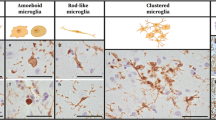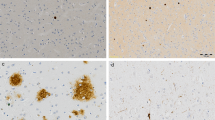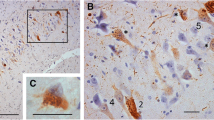Abstract
The extent of DNA fragmentation analysed using the TUNEL technique was evaluated in post-mortem human brain tissue. Twenty-four patients with clinical and histopathological diagnosis of Alzheimer’s disease (AD) and a short post-mortem delay were analysed. We report an increase in the count of TUNEL-labelled cells as the pathology of AD intensifies. Our results point out a significant correlation between neurofibrillary tangle and senile/neuritic plaque score and TUNEL-labelled cells. Patients with two copies of apolipoprotein (Apo) E ɛ4 allele had highest number of histopathological hallmarks lesions of AD, whereas the ApoE genotype did not significantly influence the density of TUNEL-positive cells. No significant correlation was found between β-amyloid protein load and TUNEL-labelled cells. There was no relationship between the age at death, age at onset, extent of astrogliosis or microgliosis and TUNEL-labelled cells in our material.
Similar content being viewed by others
Author information
Authors and Affiliations
Additional information
Received: 23 November 1999 / Revised: 18 January 2000, 22 February2000 / Accepted: 22 February 2000
Rights and permissions
About this article
Cite this article
Overmyer, M., Kraszpulski, M., Helisalmi, S. et al. DNA fragmentation, gliosis and histological hallmarks of Alzheimer’s disease. Acta Neuropathol 100, 681–687 (2000). https://doi.org/10.1007/s004010000228
Issue Date:
DOI: https://doi.org/10.1007/s004010000228




